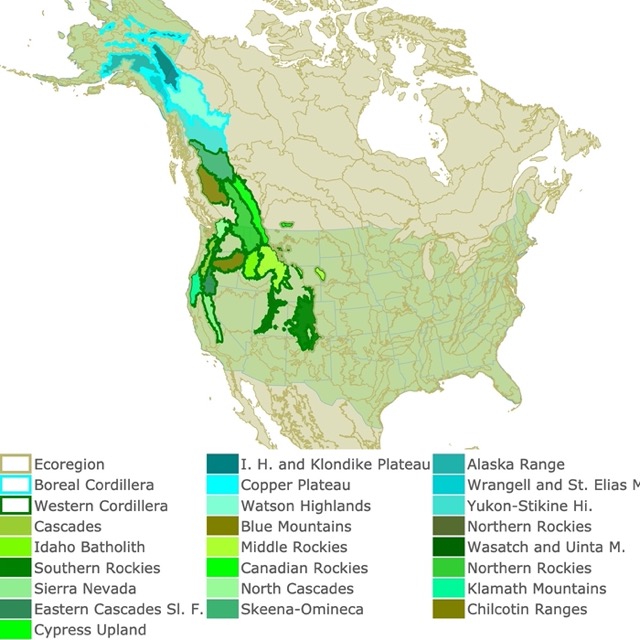New World Deer Habitat Map
This map shows the overlapping habitats of Capreolinae also known as New World Deer. The ring around the images has the colors of the different ecoregions, each genus occupies. Due to range overlapping, a single group might have more than one color. Each image is a button that you can select to pick the distribution of a particular genus. Zoom in the map to take a closer look! Hover over, to get the name of the ecoregion. For more information scroll down.
New World Deer or Capreolinae
The Capreolinae is a subfamily of the true deer or Cervidae family. True deer are hoofed ruminant mammals. The Cervidae is composed of two main groups the Cervinae and the Capreolinae.
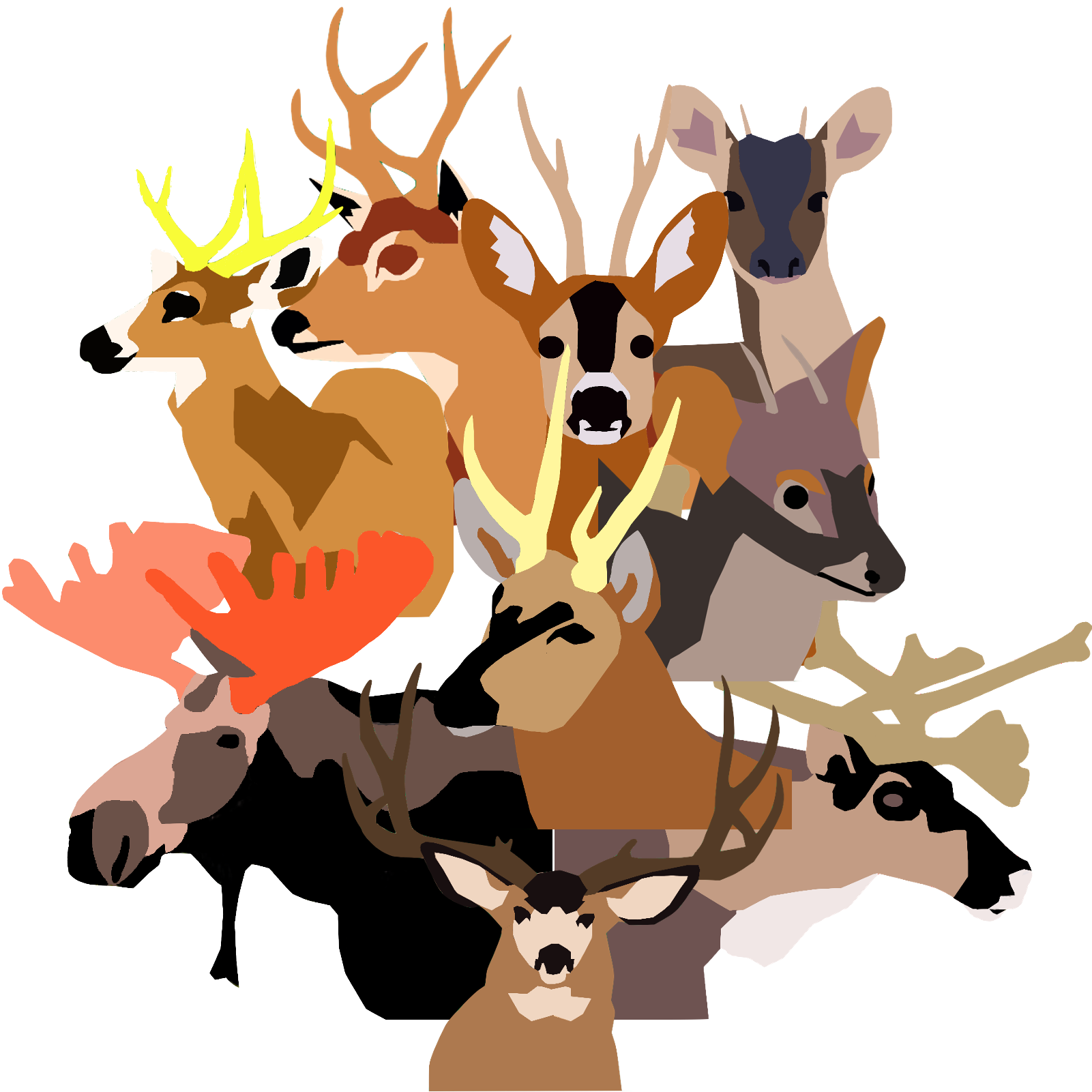
Capreolinae are also known as New World deer because most of the species from this group are found in North and South America.
Until recently this subfamily was also known as Odocoileinae, since one of its most successful members Odocoileus virginianus was highly successful and widely distributed.
The main characteristic of Capreolinae is the metacarpal foot structure. All modern deer have lost part of their metacarpal bones. The New World Deer have retained the distal or lower part of the lateral metacarpals (telemetacarpal). The Old World deer or Cervinae retain only the upper or proximal remnant of the lateral metacarpal or plesimetacarpal. Source: Cervids.
Capreolinae are also characterized by pedal glands in the hind legs and tarsal glands are also always present. Another feature of this group is that their antler cycle pauses between the pair being shed, and the new pair that begins growing. Source: http://www.ultimateungulate.com/artiodactyla/Capreolinae.html
In case you would like to have a glimpse of deer up and close, there are different options available. There are deer sanctuaries, and zoos where it is possible to see them. You can check different locations on Tiqets. Tiqets provides easy and quick access to venues and attractions worldwide. To find out more Click here!
Capreolinae Classification
The New World Deer are classified in nine major Genera. Common names and species are also included. Source: ITIS.
The table below only includes existing groups.
| Subfamily | Genus | Species |
| Capreolinae | Alces | Moose or Eurasian elk or Old World elk A. alces |
| Rangifer | Caribou or reindeer R. tarandus | |
| Capreolus | Western roe deer C. capreolus Eastern roe deer C. pygargus | |
| Hippocamelus | Taruca or Peruvian Guemal H. antisensis South Andean Deer or huemul H. bisulcus | |
| Mazama | Gray brocket M. gouazoubira Amazonian brown brocket M. nemorivaga Central America red brocket M. temama Yucatan brown brocket M. pandora Small red brocket or Bororo M. bororo Dwarf brocket M. chunyi Pygmy brocket M. nana Merida brocket M. bricenii Little red brocket M. rufina American red brocket M. americana | |
| Odocoileus | White tailed deer O. virginianus Mule deer O. hemionus | |
| Ozotoceros | Pampas deer O. bezoarticus | |
| Blastocerus | Marsh deer B. dichotomus | |
| Pudu | Northern pudu P. mephistophiles Southern pudu P. pudu |
Alces or Moose
The genus Alces has one species called Alces alces commonly known in North America as Moose. It is important to clarify that even though it is called elk in Europe, it is a completely different species to the elk found in America called Cervus canadensis, also known as the wapiti. To avoid confusion we will refer to it as moose or Alce.
There are eight existing subspecies of Alces. Four of them live in North America.
Moose are the largest members of the deer family. They can weigh up to 1200 pounds (544 Kg) and can grow to 6.5 feet (1.9 m). This height does not include raised head and antlers. Their body length is 8 to 10 ft (2.4 to 3 m).
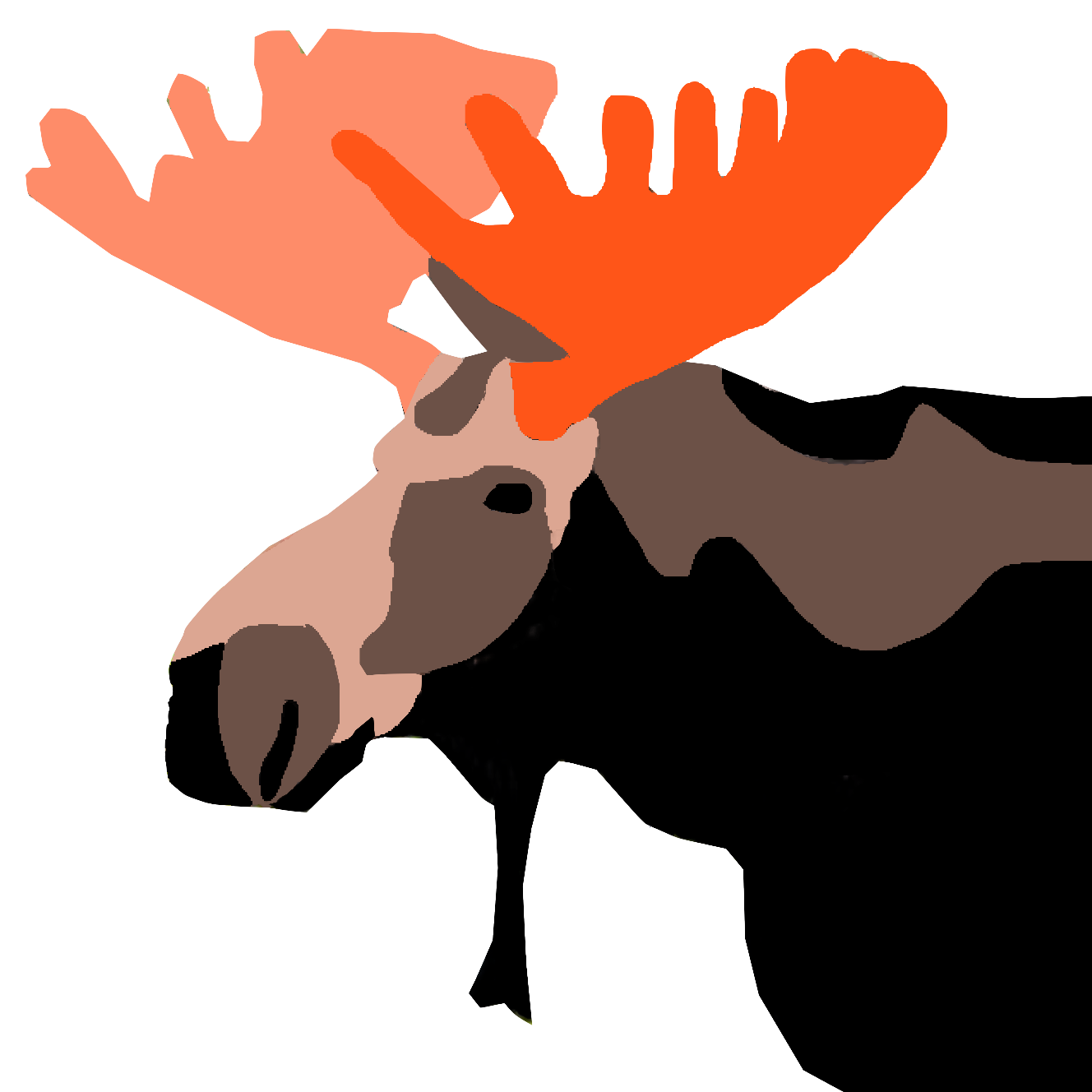
Alces fur is light to dark brown. A flap of skin that hangs from their throat is called a dewlap.
Males have antlers that can grow to six feet across. The antlers are covered in a velvety texture, full of vessels that help the antlers grow. This velvet is removed in September by rubbing; giving the antlers a different color.
Because of their size and insulating fur, moose are limited to cold climates. Therefore, they are found throughout Temperate, Subarctic, and Arctic North America. They are also found in Northern Europe, and Asia, close to the Arctic.
Forested areas with streams and ponds are their ideal habitat, since moose eat shrubs, aquatic plants, twigs, and woody plants. They can eat up to 73 pounds/day in the summer to 34 pounds/day in winter.
Adult moose can use their hoofs to defend themselves, but if they are young, sick or old they can be preyed on by bears or wolves.
Moose are mainly solitary animals, they do not live in groups.
Moose used to live as far as the Pyrenees in Southern France in the Middle Ages. Habitat loss have retreated them to Scandinavia and Russia. In the 1990's much of its population started declining in North America. The cause is believed to be infections and infestations. Source: National Wildlife Federation.
If you are interested in finding or watching this beautiful creature from a distance, or other cervid, I suggest you get this binoculars found on Amazon: HD Professional, Waterproof, Fog proof Binoculars; ideal for Traveling and Outdoor Sports.
Rangifer or Reindeer and Caribou
Reindeer and Caribou belong to the same species. They are both Rangifer tarandus. They are found in the Arctic tundra and adjacent boreal forests of North America, Europe, and Asia.
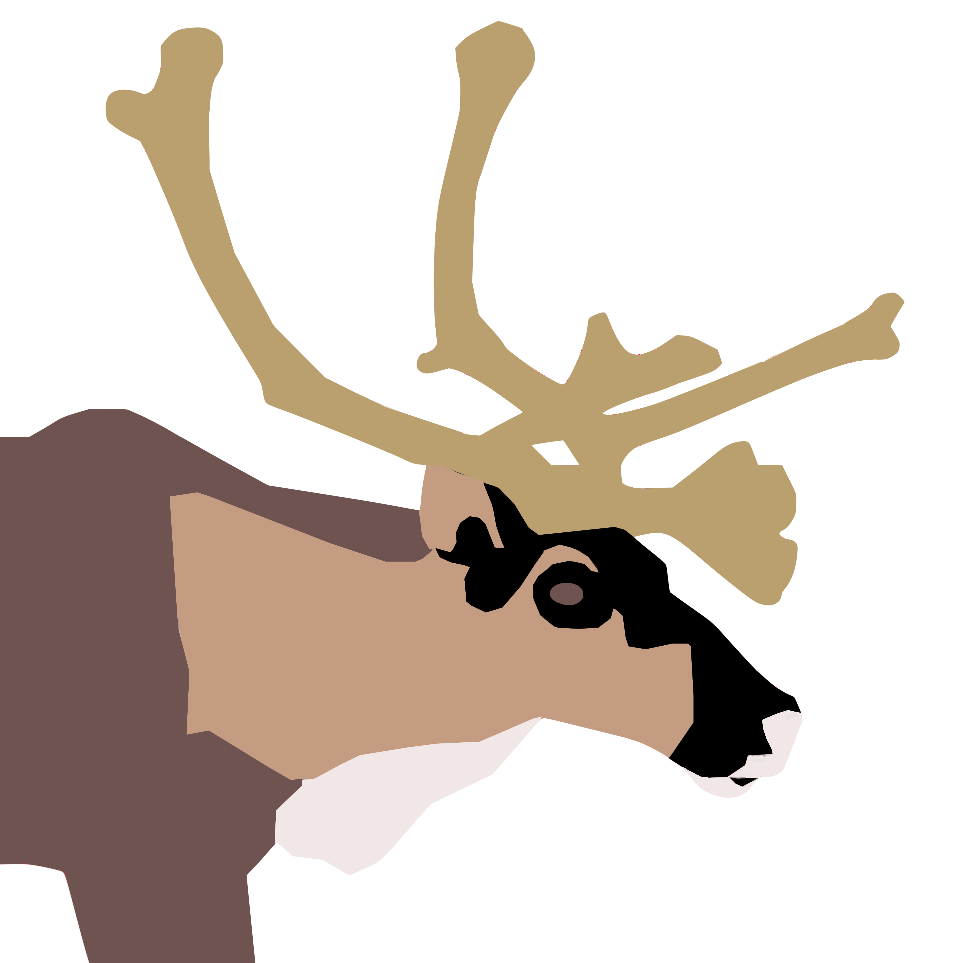
Caribou is the name given to the group that lives in North America. Caribou roam large extensions of land. Sometimes they travel 3,000 miles (4,800 Km) searching for food.
To learn more about the caribou, and their journey, I suggest you read this book from Amazon A Thousand Trails Home: Living with Caribou.
Reindeer is the name given to the groups that live in Europe and Asia. Most of the reindeer have been fully domesticated.
Rangifer are herbivorous. They eat mosses, lichen, and grasses. The diet and behavior of caribou makes them ideal to redistribute seeds and never feed excessively in a single area.
Both males and females have antlers. They use them to dig lichen, and grass, like a snowplow during winter. Males also use the antlers to compete during the mating season.

Their hooves are like snowshoes. They are hollow to make them lighter for walking in snow. They also have a cloven shape to redistribute the weight and dig in the snow for food.
To stay warm they have a coat with two layers of fur. The hair also has pockets of air to keep them insulated from the cold, and provide some buoyancy to float when swimming. Source: Artic Kingdom
Rangifer are the only deer that have hair covering their noses to keep them warm.
Reindeer are used as beast of burden, farmed for their milk, meat, and furry skin. Source: FDA.gov
As evidence of how beautiful, useful, soft, and warm reindeer hides may be, you can actually buy them from farmed reindeer. This is the link from Amazon: Reindeer Hide Rug. I personally prefer to use them as chair cushions.
Capreolus or Roe Deer
Roe deer live mainly in Europe and Asia. They live in small forests, forest steppe, and high grass meadows. They specially prefer small insular forests among croplands.
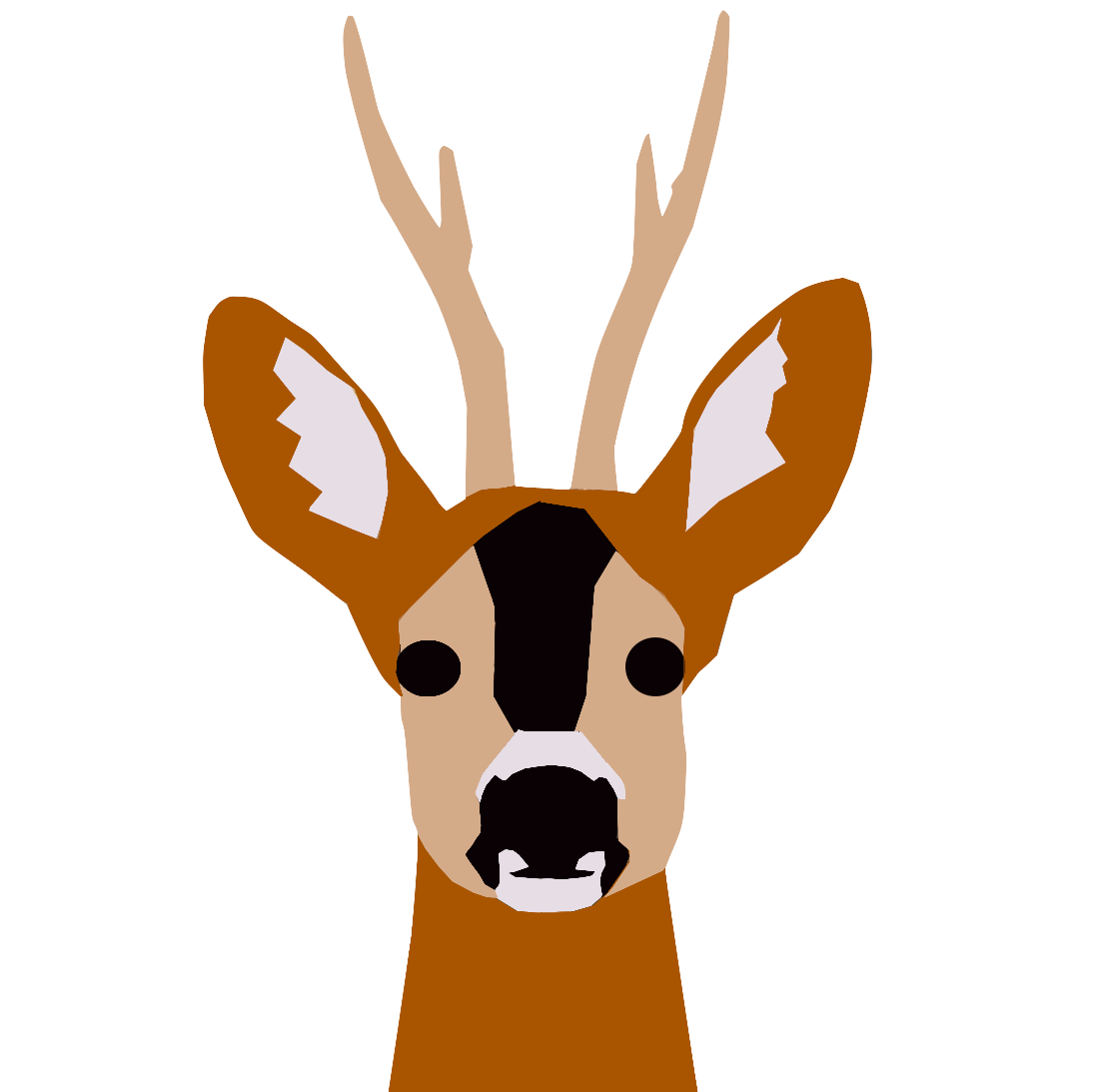
Roe deer feed primarily on herbs, leaves, fruits, buds, sedges, and cereal.
There are two species of Capreolus, Capreolus capreolus or Western Roe Deer and Capreolus pygargus Eastern Roe Deer.
The roe deer is a relatively small deer. with a body length of 4.4ft (135 cm) in the Western Roe deer and 4.8 ft (146 cm) for the Eastern Roe deer.
Capreolus capreolus is the only rumiant showing delayed implantation. This means the eggs are fertilized shortly after breeding, but remain in the uterus for 4.5 - 5 months before actual fetal development commences. The gestation period is between 264 and 318 days.
They can be solitary or live in small family groups.
The populations of the two existing species have increased in the 20th century. This has resulted in high hybridization rates.
They are not threatened and are subject to hunting for their antlers and meat. Source: Animaldiversity.org
Hippocamelus Huemul , Guemal, or Taruca
Hippocamelus live in the Andes mountains of South America. They usually live up in high elevations in the summer, and go to the valleys in winter to get some shelter.
They are stocky creatures, with short legs. They are herbivorous animals that eat lichens, and grasses that grow between rocks in high peaks.
Hippocamelus live in groups of varying sizes.
There are two species of Hippocamelus
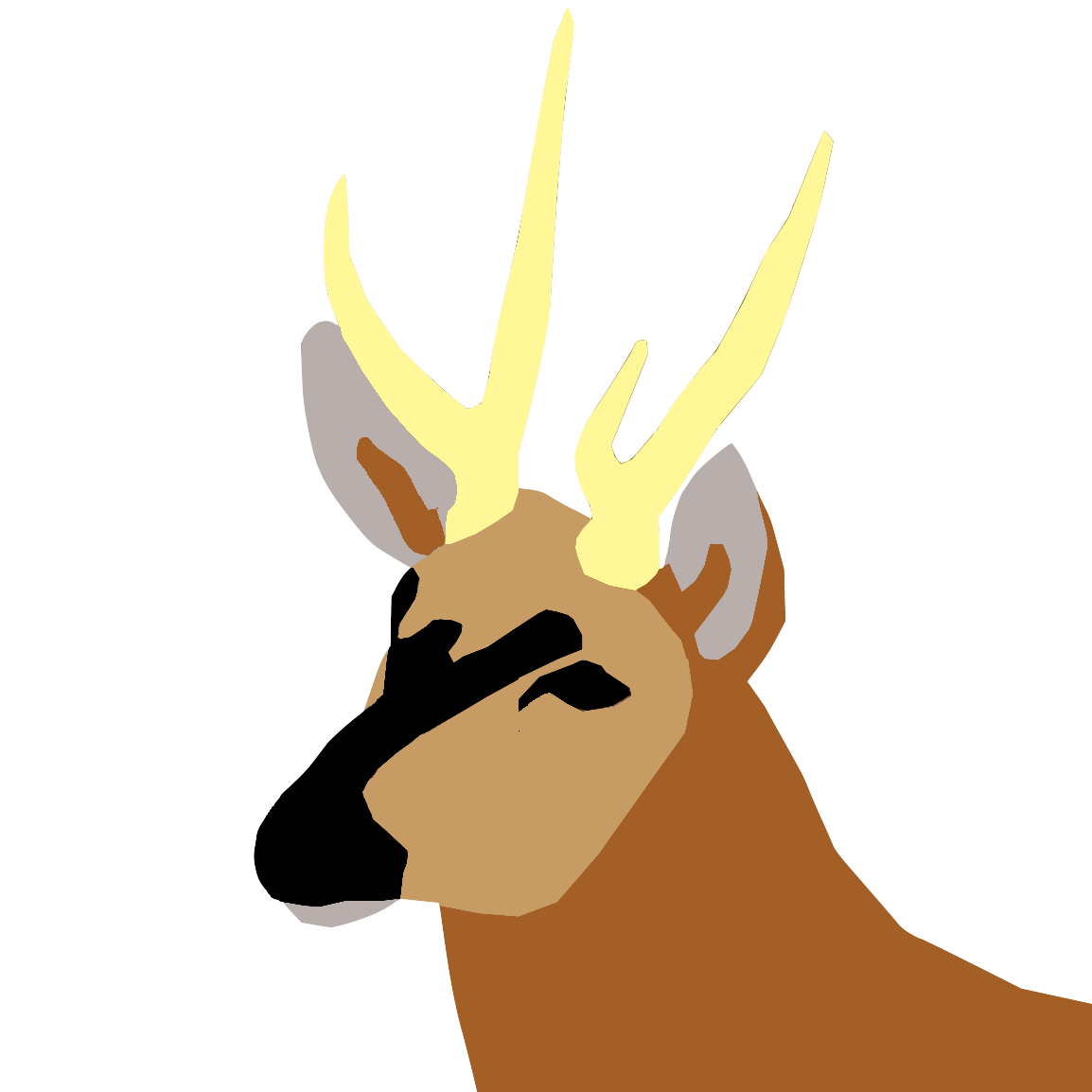
Hippocamelus antisensis, Peruvian Guemal or Taruca live in the Andes mountains of Peru and Bolivia. They are diurnal species.
Tarucas measure 150-170 cm (5-5.6 ft) in length. They have a coat of brittle hair that can be yellow to brown to gray.
Tarucas have a very unique social structure. The herds are constantly changing but they are led by a female.
Hippocamelus bisulcus or Patagonian Huemul lives close to the Chilean Patagonia. It has a body length of 69 in (175cm).
The Huemul is quite tolerant of humans as long as they are not harassed by people and dogs.
The Taruca conservation is vulnerable, while the Huemul conservation is endangered. Source: Ultimateungulate.com
Mazama or Brocket Deer
The Brocket deer has several species present in forest thickets in Central and South America. At first there where several distinct populations, that eventually were elevated to species.
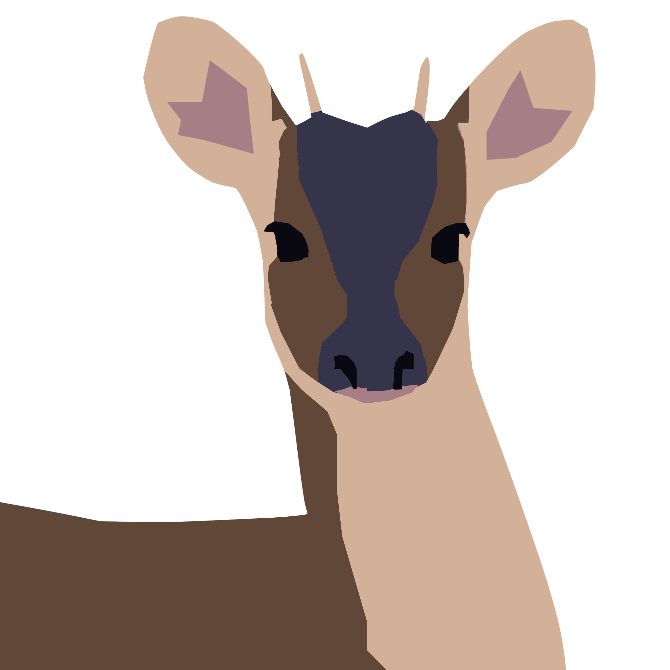
The Mazama mainly feeds on leaves, buds, shoots, fruit, fungi, and grasses.
Brocket deer are small in size with head to body length of about 57 in (144 cm).
Brocket deer are very shy and difficult to observe.
Mazama has low endurance and can be overtaken by dogs. Its main predators also include humans, jaguar, eagles, snakes, and puma. Source: Ultimateungulate.com.
According to IUCN Red List, most Mazama species have vulnerable conservation and some of their population is unknown.
If you would like to have deer decor in your home, but you would not like a preserved animal, I suggest you get this wall ornament found on Amazon: Deer Head Wall Decor, it is a Faux Taxidermy Animal Head Wall Art. It is a Geometric Buck Deer Head Bust for hanging on your Wall.
Odocoileus Mule Deer or White Tailed Deer
Both species of Odocoileus live in North America. They have brown to grey coats and large ears (hence the name Mule deer for one of the species).
They feed on soft and easily digestible plants. Whitetail deer also feeds on berries, and acorns. Mule deer also feeds on shrubs and bushes.
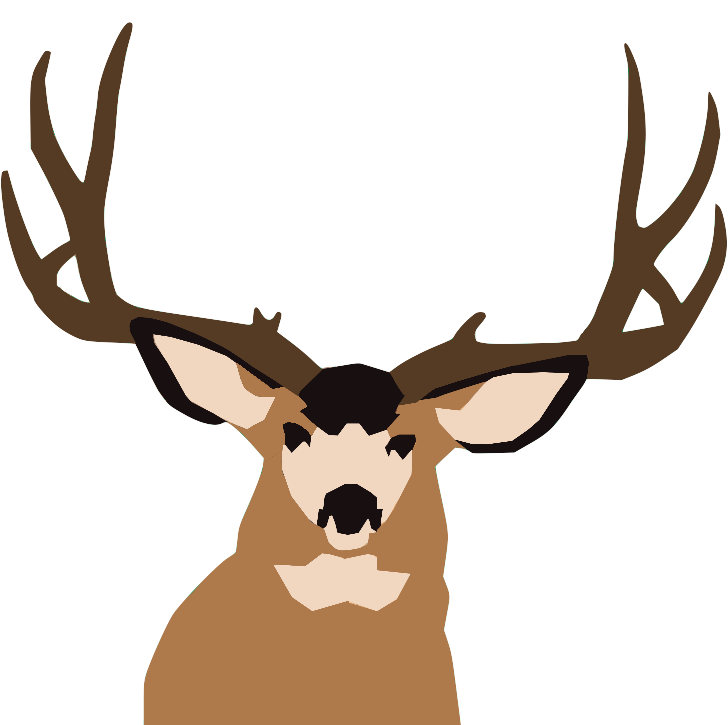
Odocoileus hemionus or Mule deer is limited to Western North America, while Odocoileus virginianus White Tailed deer lives in North, Central and Northern parts of South America.
The Whitetail Deer or Virginia Deer is the most widely distributed deer in the American Continent.
The size of the Whitetail Deer is highly variable, and follows Bergmann's Rule. It broadly states that the closer a species lives to the Equator the smaller it is. The further it lives from the Equator it needs to be larger to conserve heat better. Zooportraits.
Therefore, Whitetail Deer in Canada may reach 400 lb. (180 kg) while in Florida they can be 77 lb. (35 Kg). Their body length ranges from 37 to 87 in (0.9 to 2.2 m).
Whitetail Deer population is controlled through hunting. Source: Discoverlife.org
If you like to hunt Virginia deer and ran out of ideas on how to cook game, I suggest you get this book found on Amazon: The Wild Game Cookbook: Cooking Wild Game Using Smoker and Grill, Complete Cookbook with Tasty Recipes of Game, Birds, Fish and Etc.
Also if you are interested in cooking wild game, you will definitely like to check these spices for meat eaters MeatEater - Steven Rinella's Charismatic Megaspices Essential Pack 4 Pack Set.
The Mule Deer Odocoileus hemionus unlike the White Tailed Deer has a black tip in its tail.
Mule deer body length measure is 3.9 to 6.9 ft (1.2 to 2.1 m).
Mule deer antlers bifurcate. They "fork" as they grow, rather than branching from a single main beam, as it happens with White Tail Deer.
Mule deer is one of the most iconic in the American West. They are adapted to arid and rocky environments.
Western Colorado had one of the largest Mule Deer herds. These populations are currently declining. Some of their leading predators include bears, coyotes, wolves, and bobcats. Source: NWF.org
Ozotoceros Pampas Deer
Ozotoceros bezoarticus is a species of deer that lives in the Grasslands of South America.
They occupy grasslands at low elevations, that are temporarily inundated with fresh or estuarine water. They also live in areas with winter drought or no permanent water.
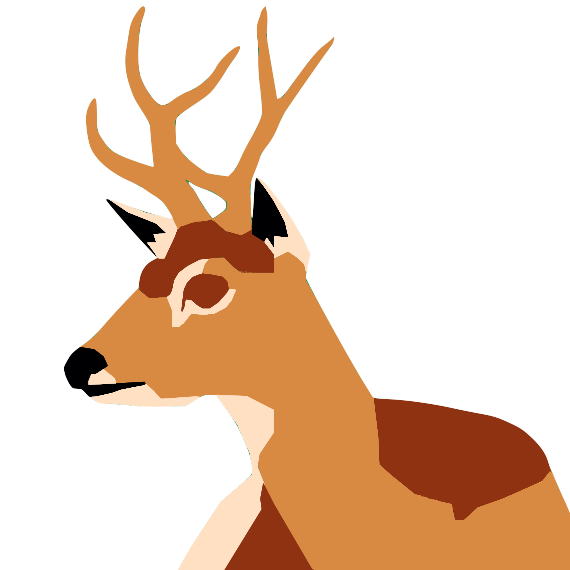
The Pampas Deer is herbivorous, feeding on shrubs, and new growth of greens.
The Pampas Deer is a medium size deer with average body length of 51 in (1.3 m). Their coat color may be brown to yellow.
Their home range is unknown, but it is believed they are largely sedentary, which makes them easy prey to humans. They are usually individual organisms but sometimes are found in groups of 5 to 6 individuals.
The Pampas Deer was greatly appreciated by the local Indians. Unfortunately the price of its skin, and stomach stones used for medicinal purposes, drove their populations to a rapid decline.
Much of their original habitat has been modified for agriculture. They are currently an endangered species. Animal Diversity.
If you want to visit the natural habitat where some of these deer species live, you can always travel to one of the sites mentioned here. To compare airline costs, you can use CheapOair. CheapOair has prices from different airlines, where you will find the location you want and the value you are looking for. To see the deals Click Here!
Blastocerus or Marsh Deer
Blastocerus dichotomusor Marsh Deer is the largest South American deer. They live in marshy habitats in Brazil, Argentina, Peru, and Paraguay.
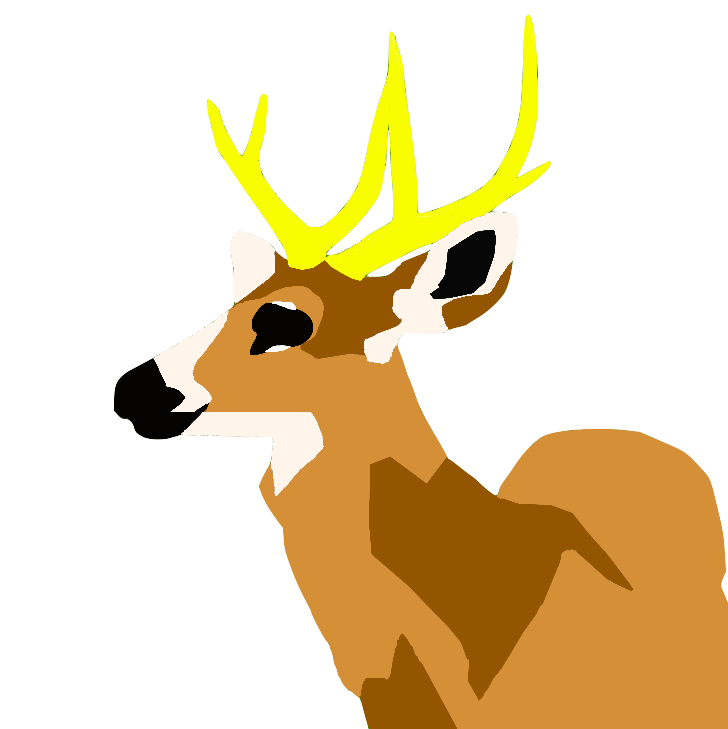
Blastocerus body length is about 60 in (153 cm). Their antlers have a characteristic dichotomous branching pattern, their ears are noticeably large,
Pampas deer are usually solitary and may be in aggregations of up to 6 deer. Research Gate.
The major threats to this species are agricultural development, dam construction, dog attacks, and poaching. Pampas Deer.
Pudu
The Pudu is the world's smallest deer. There are two genus of this deer.
Northern Pudu or Pudu mephistophiles that live in Northern South America (Colombia and Venezuela).
Southern Pudu or Pudu puda, that lives in Southern South America (Chile and Argentina).
Their sizes range from 33 in (0.85 m). Their antlers are short and simple spikes.
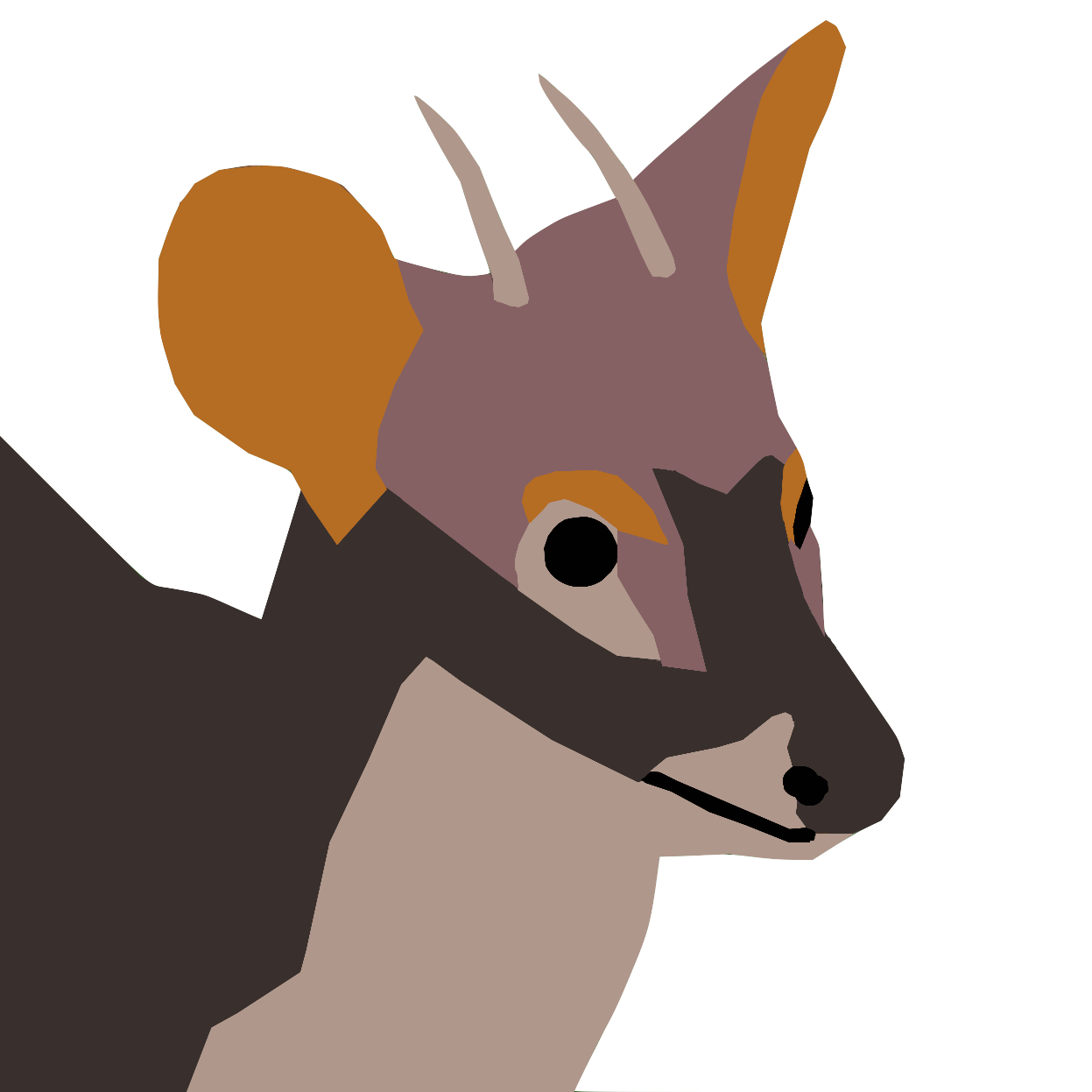
Southern Pudus live in previously disturbed forests, temperate evergreen forests and deciduous forests. They usually occupy lowlands below 5,577ft (1,700m).
Pudus prefer to live at the edges of forests or clearings where there are abundant small, growing plants.
Southern Pudus molt twice a year. Their color is brown with red markings on the ears and chin.
Southern Pudus are active during day and night. They are not solitary but their groups are of 2 or 3.
Southern Pudus main predators are Pumas. Their current status is listed as threatened, on the IUCN Red List.
Because they are sought after as pets, their lower populations are also affecting Puma populations. Source: AnimalDiversity.org
Northern Pudus live on altitudes between 9,842 ft to 13,123 ft (3,000 m and 4,000 m).
Northern Pudus have a brown coat that is thick and also works as protection from harsh elements. Their face is usually darker than the rest of their coat.
Northern Pudus are very shy and there is not much information about their behavior, and feeding habits. World Deer.
Resources for Capreolinae Map
The shapefiles to create the map with ecoregions of the world were obtained from WWF. The shapefiles with the countries of the world were obtained from Natural Earth.
The distribution of Blastoceros dichotomus as well as for Ozotocerus bezoarticus is so spotted that I included their former or historic ranges.
Alces distribution was obtained from JWW
Other resources for Capreolus came from JWW
Hippocamelus distribution was obtained from: http://www.ultimateungulate.com/Artiodactyla/Hippocamelus_bisulcus.html and http://www.ultimateungulate.com/Artiodactyla/Hippocamelus_antisensis.html
Mazama distribution from Researchgate and M. Bricenii.
Mule Deer Distribution from WAFA.
Distribution of Pudu mephistophiles was found in Northern Pudu.
The distribution of Pudu puda is from Researchgate
This map will be updated with new data! To receive updates on this and more nature maps, join my email list!!!!!!!
Made by Luz K. Molina with D3.js.


